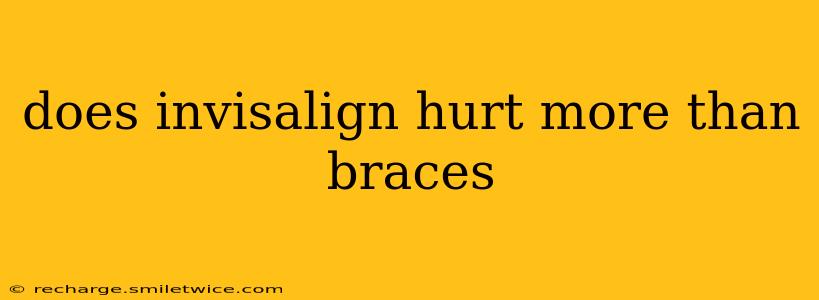Does Invisalign Hurt More Than Braces? A Comprehensive Comparison
The age-old question for orthodontic patients: which is more painful, Invisalign or traditional braces? The answer, unfortunately, isn't a simple yes or no. Both Invisalign and braces can cause discomfort, but the type and intensity of pain vary significantly from person to person and depend on several factors.
This article will delve into the pain experiences associated with both treatments, comparing their discomfort levels and addressing common concerns. We'll also tackle some frequently asked questions to provide you with a clearer picture before embarking on your orthodontic journey.
What Causes Discomfort with Invisalign and Braces?
Both Invisalign and braces work by applying pressure to your teeth to gradually shift them into the desired position. This pressure is the primary source of discomfort. With braces, the brackets and wires can also cause irritation to the soft tissues in your mouth.
Invisalign: The initial placement of the aligners can sometimes cause slight pressure and discomfort as your teeth begin to move. Switching to a new set of aligners also often leads to a renewed feeling of pressure.
Braces: The initial placement of braces is usually more uncomfortable than the initial placement of Invisalign aligners, often involving some soreness and potential mouth irritation. Tightening appointments with braces can be more intensely painful, and the metal brackets and wires can cause sores inside your mouth.
Is Invisalign Less Painful Than Braces?
While many patients find Invisalign to be less painful overall than braces, it's not universally true. The discomfort with Invisalign is often described as more of a constant, mild pressure, while brace pain can be more intense but in shorter bursts (especially after adjustments). The intensity depends on the complexity of the treatment and individual sensitivity.
Some individuals experience minimal pain with either treatment, while others find both quite uncomfortable.
How Long Does the Pain Last?
The duration of discomfort varies between individuals and treatment plans. Generally, the most intense pain associated with both Invisalign and braces usually subsides within a few days. With Invisalign, this pain tends to be less intense and shorter-lived than with braces, especially after aligner changes. For braces, the pain is often more pronounced immediately after adjustments.
It's crucial to remember that this is a general guideline. Complex orthodontic cases will inevitably lead to longer periods of discomfort than simpler ones, regardless of the chosen treatment method.
What Can I Do to Manage Discomfort?
Both Invisalign and braces come with manageable discomfort. Here are some tips to alleviate pain:
- Over-the-counter pain relievers: Ibuprofen or acetaminophen can effectively reduce pain and inflammation.
- Saltwater rinses: Rinsing your mouth with warm saltwater can soothe irritated gums and reduce inflammation.
- Soft foods: Stick to soft foods like yogurt, soup, and mashed potatoes during periods of increased discomfort.
- Ice packs: Applying ice packs to your cheeks can reduce swelling and pain.
- Dental wax (for braces): Dental wax can help cushion your cheeks and lips from irritating brackets and wires.
Always consult your orthodontist if you experience severe or persistent pain.
Does the Type of Orthodontic Treatment Affect Pain Levels?
The complexity of your orthodontic needs will be a more significant factor in determining the level of pain you experience than the type of treatment (Invisalign vs. braces). Severe crowding, complex bite issues, or significant tooth movement will generally lead to more discomfort, irrespective of whether you're using Invisalign or traditional braces.
Conclusion:
Ultimately, whether Invisalign hurts more than braces is subjective. While many find Invisalign less painful, it's not a guarantee. The level of discomfort depends on individual factors, the complexity of the orthodontic case, and even the orthodontist’s technique. Open communication with your orthodontist is key to managing any discomfort and achieving the best possible outcome. Remember to follow their aftercare advice diligently to minimize pain and maximize comfort throughout your treatment.
